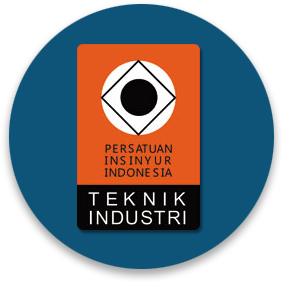Forecasting Intermittent Demand For MRO Spare Parts
Abstract
In the face of current global economic challenges, maintaining efficiency is the core of inventory management and order fulfillment is crucial for any heavy equipment industry looking to change the supply chain. Along with the complexity of increasing costs, accelerating inventory fulfillment, delivery order commitment fulfills demand. It can be seen that some of the conditions caused by the recycling activity have caused a gap between the demand and the sales made. That the forecast is still far from expected to meet real sales demand, if it continues to allow for unrealized sales and market losses. The phenomena to be known in this study include the expectation of accurate predictions about the availability of spare parts so that it meets customer needs. Utilize this type of quantitative research, based on historical demand data that reflects the nature of demand patterns by improving the accuracy of stock stocks and the level of service related to operating activities against meeting target expectations and the reality of results obtained. Real demand data based on demand turnover ratio in 2017-2018, in selecting the best forecast model of trend analysis is done with the result of setting exponential growth giving the smallest value of MAPE 12,789 MAD 11,333 MSD 271,595. Trend analysis results show that data plots do not fluctuate normally, so the assumption test is performed to calculate the number of requests (demand size) and the time between arrival of requests (inter-demand interval). Testing the assumption of demand size (zt) following the ARIMA model (0,1,1), it is found that stationary data from outputs are produced for ACF plots and PACF replacement data have been considered. As an example of the safety stock calculation results with a 95% service level such as depleted, the spin-on oil filter reached 4,248 pcs from the previous forecast of 4,08 pcs. In the future, it will not only be forecasting of existing secondary data, but will be upgrading from business model to final delivery as the industry becomes more competitive.
Keywords
Full Text:
PDFReferences
Alfaki, M. A., & Masih, S. B. 2015. Modeling and Forecasting by using Time Series ARIMA Models. International Journal of Engineering Research & Technology, Vol. 4 (3), 914-918.
Aye, G. C., Balcilar, M., Gupta, R., & Majumdar, A. 2015. Forecasting aggregate retail sales: The case of South Africa. International Journal of Production Economic, 160, 66-79.
Chitale, A.K., R. C. Gupta. 2014. Materials Management: A Supply Chain Perspective 3rd Edition. Delhi: PHI Learning Private Limited.
Claveria, O., and Datzira, J 2010. Forecasting tourism demand using consumer expectations. Tourism Review, 65, 18-36.
Dobrican, O. 2013. Forecasting Demand for Automotive Aftermarket Inventories. Informatica Economica. 17 (2), 119–129.
Guga, E., & Musa, O. 2015 Inventory Management Through EOQ Model, A Case Study of Sphresa Ltd., Albania. International Journal of Economics, Commerce and Management, 3 (12), 174–182.
Heizer, J., & Render, B. 2011. Manajemen Operasi, Jakarta: Salemba Empat.
Jacobs, FR., Chase, R.B. 2014. Operation and supply chain management. Fourteenth Global Edition.
New York: Mc Graw-Hill Publisher.
Jha, V. 2012. MRP-JIT Integrated Production System. International Journal of Engineering Research and Applications (IJERA). V 2 (4) 2377-2387.
Kasmir. 2013. Analisis Laporan Keuangan. Edisi 1. Cetakan ke-6. Jakarta: Rajawali Pers.
Pujawan, N., Arief, M.M., Tjahjono, B., & Kritchanchai, D. 2015. An Integrated shipment planning and storage capacity decision under uncertainty. International Journal of Physical Distribution & Logistics Management, Vol. 45 No. 910, 913-937.
Relph, G., & Milner, C. 2015. Inventory Management: Advanced Methods for Managing Inventory within Business System. London Kogan Page Publishers.
Ren, L., & Glasure, Y. 2010. Applicability of the Revised Mean Absolute Percentage Errors (MAPE) Approach to Some Popular Normal and Non-normal Independent Time Series. International Atlantic Economic Society, Vol. 15 No. 1, 409-420.
Ristono, A. 2013. Manajemen Persediaan. Yogyakarta: Graha Ilmu.
Russell, Roberta S., Bernard W. Taylor. 2014. Operation and Supply Chain Management 8th Edition.
Sett, B.K., Sarkas, B., & Goswami, A. 2012. A Two Warehouse Inventory Model with Increasing Demand and Time Varying Deterioration. International Journal of Scientia Iranica, Vol. 19 No. 6, 1969–1977.
Sofyan, D.K. 2013. Perencanaan & Pengendalian Produksi. Yogyakarta: Graha Ilmu.
Sudana, I.M. 2011. Manajemen Keuangan Perusahaan Teori dan Praktik. Surabaya: Penerbit Erlangga. Waluyo, 2011. Perpajakan Indonesia Edisi 10 Buku 1. Penerbit Salemba Empat, Jakarta.
Wardono, Agoestanto, A., & Rosidah, S. 2016. ARIMA Method with The Software Minitab and Eviews to Forecast Inflation in Semarang Indonesia. Journal of Theoretical and Applied Information Technology, 94 (1), 61-76.
Yuniastari, N.L.A.K., Wirawan, IGP.W.W. 2014. Peramalan Permintaan Produk Perak Menggunakan Metode Simple Moving Average dan Exponential Smoothing. Jurnal Sistem dan Informatika. V 9 (1) 97-106.
Refbacks
- There are currently no refbacks.
Copyright (c) 2020 Prosiding Seminar Nasional Mercu Buana Conference on Industrial Engineering

This work is licensed under a Creative Commons Attribution-ShareAlike 4.0 International License.
Journal ISSN:
| e-ISSN | |
| 2988-4284 |
Tim Editorial Office
Proceeding Mercu Buana Conference on Industrial Engineering
Program Studi Magister Teknik Industri Universitas Mercu Buana
Jl. Raya Meruya Selatan No. 1 Kembangan Jakarta Barat
Email: [[email protected]]
Website: https://publikasi.mercubuana.ac.id/index.php/mbcie/
The Journal is Indexed and Journal List Title by:
in Collaboration with:








